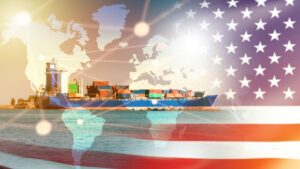Time to Reset the U.S. Trade Agenda
Over the past three years, U.S. Trade Representative Katherine Tai and National Security Advisor Jake Sullivan have worked to articulate a “worker-centered” trade policy while arguing for a “new Washington consensus” in U.S. international economic policy that will foster global investment and cooperation on issues like climate and development. Tai, Sullivan, and other U.S. officials have succeeded in laying out a vision for American industrial policy, one that has attracted hundreds of billions of dollars of announced investment in U.S. computer chip manufacturing and clean energy technology. Treasury Secretary Janet Yellen also has popularized the concept of “friendshoring”—the idea that U.S. allies and partners can benefit as multinational corporations diversify away from China. This term first appeared in a 2021 White House report on supply chains.
But when it comes to the brass tacks of trade—trade deals, tariff lines, the paperwork that companies have to file at the border, and other mechanics—U.S. President Joe Biden’s administration has not articulated a coherent agenda. At times, the administration has tried to use the specter of China’s economic threat to generate support for trade deals. One notable example is its signature Indo-Pacific Economic Framework (IPEF), which is intended to strengthen economic relations between the United States and countries across the Pacific. But geopolitical arguments for deals are failing to carry the day. Last November, deep congressional skepticism and electoral concerns spurred the administration to indefinitely postpone the IPEF trade pillar, and it is unclear whether it will complete the work even after the 2024 election.
Former president Donald Trump, in his current campaign to return to the White House, does have a clear vision for trade: he has announced plans to deploy tariffs and other protectionist measures to support favored U.S. industries. The architect of Trump’s trade policy between 2017 and early 2021, former U.S. trade representative Robert Lighthizer, has argued that the United States should vigorously deploy tariffs and other trade restrictions both to protect U.S. industry and to force not only China, but a variety of European and Asian countries, to cease unfair trade practices. However, a number of experts have raised concerns about the economic impacts of these policies as well as the risks they would pose to U.S. geopolitical relationships.
Resetting America’s trade agenda and developing a trade vision capable of drawing broad support across Washington is going to require the government to, as Steve Jobs would have said, “think different.” Rather than treating trade deals as a geopolitical endeavor that the United States should suffer through to support America’s allies and partners, or pursuing Trump’s vision of simply reducing trade (the geopolitical argument), the United States should get back to a basic premise that has guided successful trade policy in the past—that policymakers can develop and promote trade policies that advance American economic interests as well as American geopolitical interests.
05/20/2024 | Peter Harrell | Carnegie Endowment for International Peace
Designing a New Paradigm in Global Trade
Following are excerpts from the paper published by the Center for American Progress.
The Global Arrangement on Sustainable Steel and Aluminum (GASSA)—a proposed agreement to increase trade in steel and aluminum produced in a way that emits lower greenhouse gas emissions—may be the most ambitious trade initiative pursued by the Biden administration and offers a template to move beyond the traditional neoliberal approach to free trade. Much has been written on why GASSA would be a game-changer for U.S. trade policy, including by the authors of this report. To date, however, there has been little exploration of how GASSA, or an expanded GASSA-like arrangement that includes more trading partners, would work—until now.
This report describes key decision points and makes recommendations about implementing a trade arrangement that affords preferential market access on the basis of carbon intensity and creates a common approach to address nonmarket overcapacity. These include: 1) preconditions that members of the arrangement should commit to before joining, including respect for high standard labor rights, a coordinated strategy to addressing overcapacity, and a commitment to broad industrial decarbonization; 2) a tariff structure that advantages low-carbon steel and aluminum imported from like-minded partners over dirty imports from nonmarket economies such as China; 3) the use of benchmarks, which grow more ambitious over time, to assess what counts as “low-carbon”; and 4) reforms to the nation’s customs system so that U.S. officials can distinguish between low- and high-carbon goods at the border….
While it is difficult to know exactly how the negotiations will unfold moving forward, the opportunity for the United States to create a new global trade paradigm that affords market access based on carbon-intensity and addresses nonmarket overcapacity is too important to abandon. The European Union’s Carbon Border Adjustment Mechanism (CBAM) essentially means that the European Union will continue to be important in discussions over any GASSA-like arrangement, but it may be unwilling to make the compromises necessary for a cooperative approach to decarbonizing the metals trade. For that reason, these twin objectives could very well become the basis of negotiations with other ambitious trading partners and—if successful—could become the organizing principle for a global system looking for a new means to organize and manage trade relations. Indeed, in remarks at Columbia University on April 16, Special Presidential Envoy for Climate John Podesta suggested precisely this kind of expanded approach, calling for discussions with U.S. “partners and allies around the world, from the UK to Australia to the EU.”
This strategy is particularly interesting, as it turns the traditional neoliberal approach to trade on its head. No longer would the United States or other developed economies offer market access on the promise, or in the hope, that eventually trade would lead to alignment on standards for workers or the environment. GASSA or a GASSA-like agreement, rather, would ensure that standards come first, as a prerequisite before a trading partner would benefit from preferential market access. Such a structure may start with steel and aluminum, given the sector’s unique trade exposure, but could easily encourage decarbonization and high standards in other sectors as well. This idea shares a strong sentiment with the comments made by Brazilian Finance Minister Fernando Haddad at a recent meeting with his G20 counterparts, where he called for a “new globalization” based on social and environmental principles.
05/20/2024 | Ryan Mulholland, Trevor Sutton & Timothy Meyer | Center for American Progress
The Conservative Case & The Progressive Case for Globalization
As part of the Cato Institute’s series, “Defending Globalization: Law and Politics,” two essays were published on May 30, 2024. Following are excerpts from each of them.
The Conservative Case for Globalization
by Jeb Hensarling, a Republican who represented Texas’s 5th Congressional District from 2003-2019
Today one of the greatest accolades within the conservative movement is that of “constitutional conservative,” a term meant to convey fealty to the Founding principles contained within the Declaration of Independence and US Constitution. Any conservative would be well advised to carefully reread the Declaration’s list of the repeated “injuries and usurpations” of the Crown, which evidenced its tyranny and justified American independence. The list includes “cutting off our Trade with all parts of the World.” Thomas Paine, author of Common Sense, the most influential pamphlet of the Revolutionary Era, wrote that to a trading country, freedom of trade was “of such importance, that the principal source of wealth depends on it; and it is impossible that any country can flourish … whose commerce is … fettered by laws of another.… A freedom from the restraints of the Acts of Navigation I foresee will produce … immense additions to the wealth of this country.”
In addition to Paine, most Founders believed in the goal of free trade and viewed it as necessary for the prosperity of the republic. They believed the principal and proper use of tariffs should be limited to revenue raising, not protecting domestic industries. In fact, at the dawn of our republic and for more than a century thereafter, the bulk of tax revenues were derived from import duties, given their relative ease of collection, as Phil Magness lays out in his Cato Institute essay on the history of tariffs in the United States between 1787 and 1934. The other recognized legitimate use of tariffs was to incentivize other nations to open their borders to our trade. These purposes are in distinct contrast to the purposes proposed by many today who seek to engage in industrial policy that benefits discreet economic sectors or industries or that promotes economic nationalism designed to severely limit or close off our international trade.
The Progressive Case for Globalization
by Inu Manak and Helena Kopans-Johnson
Globalization has transformed the world. Centuries ago, it brought exotic spices and wares to distant corners of the globe. More recently, it has allowed us to work, see our families, and live our lives despite the disruptions caused by a once‐in‐a‐lifetime pandemic. Trade in particular is a major component of globalization, which has lifted over a billion people out of poverty, made us more productive, and contributed to peace. Despite this, globalization and trade are under attack.
US Trade Representative Katherine Tai argued that the traditional approach to trade, focused on economic efficiency, has contributed to “a race to the bottom.” Meanwhile, President Biden has been beating the drum for his Made in America approach, even if it harms ties with our allies. Defending President Biden’s “Invest in America” agenda, Heather Boushey, member of the president’s Council of Economic Advisers, stated that “the global trading system has not always been fair, not always delivered the promised benefits to our citizens, [and] too often favored large corporate interests over workers’ interests.” The administration has thus called for a “new Washington consensus” but still has not answered the question posed by Jake Sullivan: “How does trade fit into our international economic policy, and what problems is it seeking to solve?”
What is striking about these statements is how far removed they are from traditional progressive views on trade and globalization, namely, that domestic and international prosperity are interlinked, that trade institutions support the rule of law, and that globalization is a tool for advancing well‐being among the poorest. Trade has thus been peripheral to the Biden administration’s foreign economic policy. The shift in Washington toward favoring protectionist policies over trade openness is not only bad policy, but for progressives now calling for a new approach to trade, it also cuts against the very goals they are trying to achieve.
05/30/2024 | Jeb Hensarling | Inu Manak & Helena Kopans‐Johnson | Cato Institute
U.S. Leadership on AI Global Governance
Dr. Orit Frenkel, one of the authors of this report, will be a featured speaker at a June 5 webinar cohosted by WITA and the U.S. Council for International Business, titled “Global Governance of Artificial Intelligence”. Information can be found here and below.
Artificial Intelligence (AI) is poised to become one of the most impactful and consequential societal revolutions of the 21st century, with enormous benefits and risks that the world is just beginning to understand.
This paper will outline the AI global governance landscape and associated gaps in policy in order to establish the importance of U.S. leadership in developing a global AI regulatory framework – one that protects U.S. economic and national security interests, advances U.S. competitiveness, while ensuring transparency, protecting human rights, and promoting essential democratic values – as societies attempt to set the AI rules of the road for decades to come.
The United States, the European Union (EU), and China have each embraced different AI regulatory models. The U.S. has pursued a more limited government model that fosters innovation, encourages private sector initiatives, and limits risks. The recently passed EU AI Act embraces a more restrictive regulatory role over the use and design of the technology, protecting consumers and privacy, while restricting various AI applications.
Meanwhile, China is advancing a state control model with extensive censorship and surveillance capabilities. This is especially concerning as it spreads its model when it sells technology across the Global South.
In the U.S., the Biden Administration released its Executive Order on AI (EO) in October 2023, which builds on earlier efforts to establish guardrails for industry and directs funding for R&D and talent development, while establishing a government-wide effort for AI deployment through federal agencies.
For now, the U.S. leads the world in terms of total AI private investment. However, AI is being deployed across China at a much quicker pace than in the U.S. While the U.S. still leads in AI, the Chinese government is investing considerable funding and political capital to close the gap.
Multilateral efforts to create common governance structures and guardrails for AI have accelerated, through the UN, the OECD, the G7 and other forums. U.S. leadership and its governance model are reflected in many of these early efforts.
In order to lead the way on global governance for AI, the U.S. needs to build on its current efforts in several important ways.
Read the Full White Paper Here
05/22/2024 | Dr. Orit Frenkel & Rebecca Karnak | American Leadership Initiative
WITA – We put the community in trade community.
Information about upcoming WITA and trade community events




